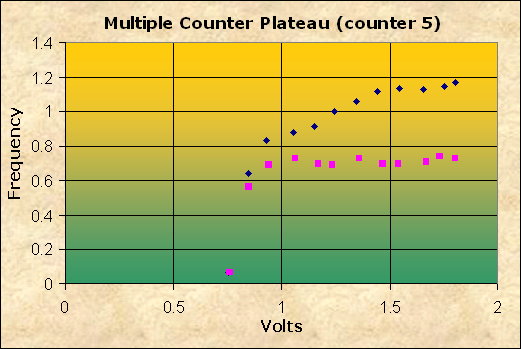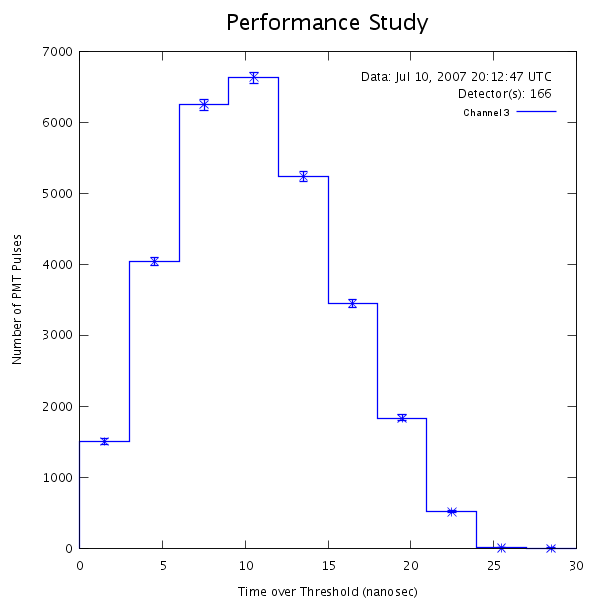Counters one, two, and five were used to plateau counter five.

The plateau appears to be around 1.06 volts. It levels out starting about there and after that the two series split, the pink staying about level and the blue sloping upwards.
These are the values for the above graph along with the counts per minute for counters one, two, and five at each voltage.
| Blue | Pink | |||||||||||||||||||||||||||||||||||||||||||||||||||||||||||||||||||||||||||||||||||||||||
|---|---|---|---|---|---|---|---|---|---|---|---|---|---|---|---|---|---|---|---|---|---|---|---|---|---|---|---|---|---|---|---|---|---|---|---|---|---|---|---|---|---|---|---|---|---|---|---|---|---|---|---|---|---|---|---|---|---|---|---|---|---|---|---|---|---|---|---|---|---|---|---|---|---|---|---|---|---|---|---|---|---|---|---|---|---|---|---|---|---|---|
| Volts | 2&5 1&2 | Counts per Minute (2&5) | Volts | 1&2&5 1&2 | Counts per Minute (1&2&5) 0.755 | 0.07 | 57 | 0.761 | 0.07 | 58
| 0.848 | 0.64 | 500 | 0.850 | 0.56 | 445
| 0.930 | 0.83 | 646 | 0.943 | 0.69 | 541
| 1.052 | 0.88 | 687 | 1.065 | 0.73 | 573
| 1.149 | 0.92 | 718 | 1.171 | 0.70 | 549
| 1.245 | 1.00 | 777 | 1.231 | 0.69 | 547
| 1.348 | 1.06 | 824 | 1.361 | 0.73 | 575
| 1.445 | 1.12 | 875 | 1.467 | 0.70 | 553
| 1.546 | 1.14 | 887 | 1.541 | 0.70 | 555
| 1.655 | 1.13 | 882 | 1.668 | 0.71 | 562
| 1.750 | 1.15 | 894 | 1.733 | 0.74 | 585
| 1.805 | 1.17 | 911 | 1.805 | 0.73 | 574
| | |||||||||||||
Counters one and two were set to a voltage of 1.103 volts and kept constant. Their coincidence was measured three times, when counter five was at 0.755, 1.348, and 1.655 volts. The frequency was 772, 766, and 796 counts per minute, respectivly. The average is 778 counts per minute. This trial used only counters two and five against one and five to see if there was a difference when the frequency of two counters instead of three was used.
Counters one and two were again set to a voltage of 1.103 volts and kept constant. Their coincidence measured three times, when counter five was at 0.761, 1.065, and 1.361 volts. The frequency was 781, 793, and 792 counts per minute respectivly. The average is 789 counts per minute.

This study was run at 1.061 volts.